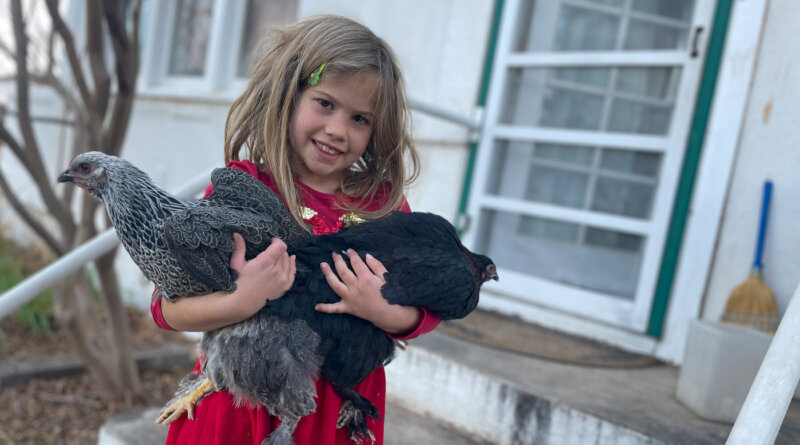Chickens and their clucks bring joy and awe : Goats and Soda : NPR

The author’s daughter, Rosy, with two of the family chickens. Among Rosy’s discoveries: “When the sun goes down, they all go up into the coop and go to bed. Nobody has to tell them it’s bedtime.”
Michaeleen Doucleff/NPR
hide caption
toggle caption
Michaeleen Doucleff/NPR

The author’s daughter, Rosy, with two of the family chickens. Among Rosy’s discoveries: “When the sun goes down, they all go up into the coop and go to bed. Nobody has to tell them it’s bedtime.”
Michaeleen Doucleff/NPR
Back in October, I was working at my desk when the phone rang. “Your order arrived. And the box is making a lot of noise,” he said. “You better get over here.”
I hopped into the car, rushed to the post office and sure enough, as I walked up to the counter, I could hear the box – or what was inside it – literally chirping.
When I returned home and opened up the box, a pile of baby chicks – just a few days old – rolled onto the floor. They looked like 15 black-and-white fluff balls, jiggling around. Goodness, gracious! They were so cute!
“Well,” I said to my husband, “we’re now chicken people.”
That’s right, I ordered 15 chicks in the mail. I didn’t do it just for the eggs. Don’t get me wrong: Fresh eggs are wonderful! But holy smokes, it is an expensive – and stinky – way to get breakfast.
Instead, our family began to raise chickens because I thought they might help with our mental health. They give us a reason to go outside every morning and evening, often around sunrise and sunset, to feed them, give them water and make sure they’re safe in the coop for the night. They’ve also helped my family learn how to swap negative emotions, such as anger, for positive emotions, such as wonder and awe.
Want to feel more wonder? Start practicing
In the past decade, neuroscientists have begun to change how they think emotions arise in our brains.
Our brains generate emotions in order to react and respond to a situation we’re in. For a long time, scientists thought these emotions were hard-wired and uncontrollable. But, as NPR has reported, neuroscientists now realize that’s not true, and people have more influence on which emotions arise than previously thought.
Specifically, our brains select an emotion as a response to a situation, and that selection depends heavily on which emotion it has selected in the past.
This idea is extremely powerful because it means people can, in a way, choose to feel positive emotions, such as awe and wonder, more frequently. All you need to do is practice having these positive feelings, and then over time, these emotions become easier to access. When you start to feel an unproductive emotion, such as anger, you can more easily swap that negative feeling for a positive one, such as awe, says neuroscientist Lisa Feldman Barrett at Northeastern University. “It may sound hokey in the abstract, but I guarantee it, that if you practice awe, that practice is essentially helping to rewire the brain. So that you can make that emotion much more easily in the future,” she says.
And that’s where the chickens come in. Chickens are an enormous source of wonder and awe.
Cultivating poultry and wonder
Wonder and awe are the emotions you feel when you encounter something so vast or so extraordinary that it makes you literally stop what you’re doing and think, “Wow, what is that?” You can’t explain it entirely because it doesn’t fit neatly into your knowledge of how the world works.
Psychologist Michelle Shiota and her colleagues have found that feeling wonder and awe does a bunch of good things to our bodies and minds. It makes you pause a bit, which in turn calms your nervous system.
“I’ve found evidence that activation of our fight-or-flight sympathetic nervous system dials back a little bit,” says Shiota, who’s at Arizona State University. “People feel an impulse to stop moving and really just take in the information about what’s happening before acting next.”
The feeling can also reduce stress, studies have found, because it makes you think beyond yourself and your own problems. It puts your problems into perspective, Shiota says..
Take, for example, looking up at the night sky. “You can look at that sky and think, ‘Wow, that’s bit,’ ” she says. ” ‘That’s so much bigger than me. So much bigger than my problems.’ No matter how real they are.
When you remember how little you truly know about the world, that can be humbling and give you a new perspective, she says. “It seems to just help us calm down a little bit in a powerful way.”
The night sky generates this feeling because it’s physically vast. But wonder and awe can also come from things that are conceptually vast, says psychologist Piercarlo Valdesolo.
Consider a petal on a rose flower. If you stop and try to understand how that petal is made, you may start to realize there’s way more to this tiny, soft petal than you previously thought. “It’s almost like you’re peering into a world that you hadn’t seen before. Something is opening up to you,” says Valdesolo, who’s at Claremont McKenna College.
And that’s exactly what has happened with my family and the 11 beautiful hens we now have in our backyard (unfortunately, not all 15 chicks survived the journey to henhood).
Chicken surprises
Over the past seven months, my husband, daughter and I have come to realize there’s way more to chickens than we previously thought.
Every day the lady birds do mysterious and mesmerizing things. “Like taking dirt baths,” says my 7-year-old daughter, Rosy. “Basically they dig a hole in the ground and rub their bodies in the dirt.”
One evening, around 8 p.m, we found one of the hens – we named her Carmel – on our roof.
“How did she get up there? Do chickens fly?” My husband asked.
I had no good answer for him but instead just enjoyed the wonder at it. (Then the next night, while we were making dinner, I kid you not, Carmel, came to the kitchen window and just stared at us.)
Chickens have an uncanny ability to put themselves to bed – on time – every night. “When the sun goes down, they all go up into the coop and go to bed,” Rosy explains. “Nobody has to tell them it’s bedtime.”

Fresh from the chicken coop eggs are nice, but our NPR chicken person says there’s another — deeper — reason to keep hens.
Michaeleen Doucleff/NPR
hide caption
toggle caption
Michaeleen Doucleff/NPR

Fresh from the chicken coop eggs are nice, but our NPR chicken person says there’s another — deeper — reason to keep hens.
Michaeleen Doucleff/NPR
And despite the fact that a chicken’s brain is the size of a few peanuts, each of the hens has a distinct and full personality. For example, Marshmallow, a white and fluffy hen, loves people. She comes over to you and almost jumps in your lap. While Marmalade is feisty. Very feisty. She’ll let you pick her up, but then she flaps her wings violently until you let her go.
For me, the most wondrous thing about chickens is their sounds – in particular, one very strange and mysterious sound.
Chickens are noisy. And most of the time, they make a sound that reminds me of a clown horn honking. But then, all of a sudden, when the chickens turned 5 months old, they started to make another very distinct sound. It goes like: buh, buh, buy, bah-gawk, with a strong emphasis on the gawk. The pattern repeats over and over for a few minutes straight.
When I heard this sound I immediately stopped what I was doing and thought, “What on Earth are they trying to tell me?” (i.e., I felt wonder.)
Then one day, when I heard this special sound, I ran outside to the coop and looked inside. It was amazing.
Inside the coop, two hens (Chocolate and Milk) were sitting down, laying eggs. A third hen (Caramel) was in the door of the coop, broadcasting the special sound.
The sound of chickens laying eggs
I realized at that moment: This strange noise is the way chickens signal that a member of the flock is laying an egg! It’s the egg-laying signal. (Why would chickens want to signal such a vulnerable and important time? I have no clue. I think only the chickens know.)
Sometimes the chickens cluck their special egg-laying song after an egg is laid. Check out this video; the egg song starts at about the 2 minute 25 second mark.
YouTube
Now when I feel anger rising in my body or my daughter feels frustrated, I sometimes remind us all of the egg-laying noise: buh, buh, buy, bah-gawk, buh, buh, buy, bah-gawk. buh, buh, buy, bah-gawk. And I kid you not, it brings a smile to everyone’s face.
Thinking back to that phone call from the post office, I can’t remember a package that has brought so much wonder into our life.



